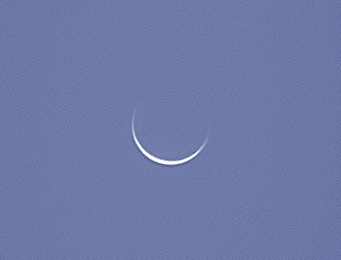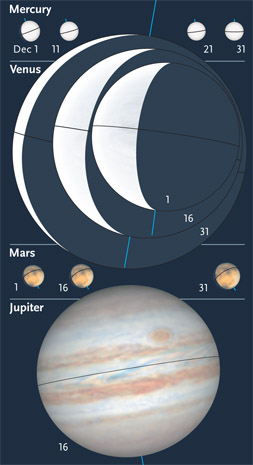Venus, the brightest planet, was fairly high in the evening sky in early December, but it’s now appearing a little lower each night. By the end of December, it will be less than 15° above the southwestern horizon at sunset for observers at mid-northern latitudes — so don’t miss out on observing it before it disappears.

S&T senior editor Dennis di Cicco captured Venus in broad daylight on May 31, 2012, 5 days before inferior conjunction.
S&T: Dennis di Cicco
Venus is usually pretty boring through a telescope – just a featureless white disk. And to make matters worse, it’s mostly pretty small — just 10 arcseconds across when it’s about to disappear behind the Sun. Compare that to Jupiter, which is never less than 30 arcseconds across.
But Venus will be at inferior conjunction, closest to being directly between us and the Sun, on January 11th. And for a few weeks either side of that date, Venus appears truly spectacular through a telescope — a long, thin crescent. In fact, Venus’s crescent is now longer, horn to horn, than Jupiter is wide. That would be impressive in any case, but it’s doubly so now, because Jupiter is also approaching its largest apparent size (on January 4th). That means that both Venus and Jupiter, the two brightest planets, will be very near their biggest in the first two weeks of January.

This excerpt from the December 2013 issue of Sky & Telescope shows the shapes and relative sizes of Mercury, Venus, Mars, and Jupiter during that month.
S&T Illustration
In fact, you can compare them directly, because Jupiter is now rising in the east-northeast shortly before Venus sets in the west-southwest. It’s no accident that they appear on opposite sides of the sky; in early January the Sun, Venus, Earth, and Jupiter will all lie on an almost straight line, with Venus and Jupiter on opposite sides of Earth.
Venus is now changing visibly from one night to the next as it scoots between Earth and the Sun; the crescent is 16% lit on December 17th, 10% lit on the 24th, and just 4% lit on New Year’s Eve. Venus’s crescent is now so long and thin that it can be seen in steadily supported binoculars, and a handful of keen-eyed observers have even spotted it without optical aid.
The crescent will be truly spectacular through a telescope near inferior conjunction, but it will also be very hard to spot low in bright twilight — and potentially hazardous if you try to spot it when it's still high, before the Sun has set. When Venus reemerges into easy view in late January it will be just as spectacular as it is now, but it will only be visible in the predawn sky — a time when most people prefer to be in bed under warm covers at this time of year.
 3
3
Comments
Anthony Barreiro
December 17, 2013 at 4:30 pm
For the past month or so I've been enjoying setting up my little refractor with a low-power eyepiece and a polarizing filter around sunset on the sidewalk in front of my home or in the park on a nearby hill and offering passersby views of Venus. Most people have never looked at Venus through a telescope, and they are surprised to see her crescent shape. In addition to the sheer visual beauty, this presents a teachable moment: why do we see only a crescent? why does Venus look like the Moon? how does the orbit of Venus compare to the orbit of Earth? how did Galileo's observations of the phases of Venus convince him that Venus is orbiting the Sun rather than orbiting the Earth? Most people are grateful for the opportunity to look through a telescope -- homeless people, parents with children, young people out on a date, older folks, the sky brings us all together. It's a great way to meet your neighbors. The only problem these days is that the Sun sets before I leave work, and Venus is already pretty low by the time I get home.
You must be logged in to post a comment.
Noel Goodisson
December 26, 2013 at 2:53 pm
What a fantastic and generous idea. A great way to meet new friends. Keep it up.
Regards
Noel
You must be logged in to post a comment.
Bob Kelly
January 8, 2014 at 7:08 pm
Saw Venus today, Wed 8th, just after 12 noon, with a large street sign blocking out the Sun. Used 8/25 image stabilized binoculars. Better after noon when the Sun is dropping downward away from Venus, decreasing the risk of viewing the Sun by accident.
You must be logged in to post a comment.
You must be logged in to post a comment.